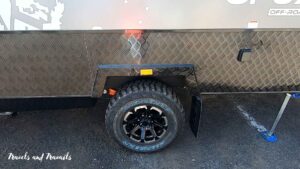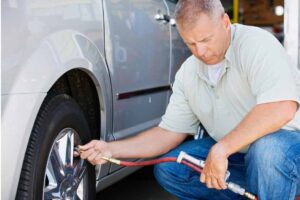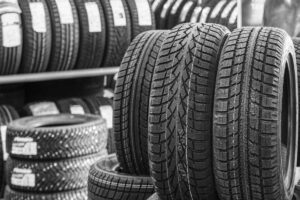The last thing you want is to pop a flat when adventuring in your RV, whether you only spend a few months of the year in the vehicle or live in it full-time. Tires will only last for so long, but you can increase their longevity with maintenance. How do you take care of RV tires?
Here are some methods for keeping your RV tires in usable condition:
- Clean and protect them
- Test the pressure
- Watch your weight distribution
- Stay out of the sun
- Use tire covers
- Know when to replace them
If you’re not already incorporating these care strategies into your overall RV maintenance routine, it’s never too late to start. You’ll be rewarded with healthy, long-lasting tires that will get you from Point A to Point B.

6 Tips for Better RV Tire Care
1. Clean and Protect the Tires
Clean tires are happy tires. Regular washings can inhibit dry rot, also referred to as sidewall weathering.
When your tires experience dry rot, they’re damaged to the point where they crack. Driving on rotted tires is a huge hazard.
Cleaning your tires also has the added benefit of maintaining their traction, as less dirt and debris are caught in the tire treads.
So how often should you get into the habit of cleaning your tires? Make it an every-other-week occurrence for tires that last long and remain strong.
You need a sturdy tire brush such as this one to clean your tires. If you already own a tire brush for car or truck upkeep, you should be able to use it for your RV tires.
You also need a big bucket of soapy water. Dip the tire brush into the suds and wipe down each tire around the perimeter. Do your best not to get the metal wheels wet; if they do, dry them quickly.
Next, it’s time to seal your tires for extra protection. A product like Meguiar’s Endurance Tire Gel will protect your tires and lend them an appealing shine for several weeks. That’s due to the copolymers and macropolymers in the formula, which can even withstand rain and a car wash.
Meguiar’s is also a UV protectant. You’ll see why that’s so important coming up. Once you treat the wheels, you should only wash them with soap and water.
Although we’re talking about tire protection in this article, if your RV has aluminum or magnesium wheels, you can clean those too. A metal polish will remove oxidation, brake dust, grease, and oil.
2. Test Tire Pressure

The next RV tire maintenance tip is regularly testing tire pressure. You shouldn’t only check the pressure of the tires attached to your vehicle but also any spare tires you carry.
When your tire pressure is too high, your health is at risk. The overinflated tires can possibly explode if they overheat or receive too much pressure when driving.
The distorted shape of the tires means that only some parts of the tire are touching the road. This might not seem like much of a big deal, but the tires end up accruing uneven wear, usually in the middle. You might need to replace your tire sooner, and its traction will likely not be as good as it should be.
Low tire pressure is just as bad in its own way. The unsteady tires are likelier to aquaplane, putting you at a higher risk of an accident when driving your motorhome in the rain.
The tires also have too much roll resistance and will require more fuel when their levels are low. Fueling up your RV is already one of the biggest expenses of ownership, so the more you have to do it, the emptier your wallet will be.
Finally, underinflated tires lack endurance. They’re likelier to tear or deflate from a puncture, and their lifespan is generally lower.
How do you know the appropriate tire pressure for your RV tires? I recommend checking your owner’s manual, as the information is usually in there.
Once you know where your RV tire pressure should be, you can check the pressure of all your tires and the spares. A digital tire gauge like this one we’ll make this a quick, efficient job.
If some of your motorhome’s tires are underinflated, add extra air until they reach the necessary pressure. Make sure you release air from overinflated tires.
All four tires should be at about the same pressure to make driving a smoother experience.
If you’re having a hard time reaching the pressure valves, valve extenders can assist in testing tire pressure and inflating the tires.
3. Watch Your Weight (and Distribution)
Another consideration when caring for RV tires is how much weight you’re applying to them.
Some RVers pay less attention to weight distribution than they should. After all, it’s not like your vehicle has a hitch, such as what you see in a travel trailer.
Nevertheless, your motorhome does have a weight limit, and you must abide by it for your safety and that of everyone in your vehicle.
When you overload your RV, you put more pressure on the entire vehicle. You stress the frame, and the added weight ultimately rests on the tires. The extra pressure can cause uneven wear on the tires and shorten their lifespan.
If you don’t know how much weight your RV can support, check your owner’s manual. Keep in mind you can always look up the manual online if you can’t find your original copy.
While getting close to the weight limit is okay, take special care never to reach or surpass it. To lighten your load, assess what you have in your RV and determine which items you can store elsewhere for your latest adventures.
How much your cargo, gear, and stuff weighs is as important as how you distribute it. By clumping everything together in one corner of the RV, the tires on that side of the vehicle receive a lot more pressure than the tires on the other side. This too will contribute to uneven wear.
4. Limit Sun Exposure
Even though they’re larger than your average car tire, an RV tire is still made of rubber at the end of the day. What is the biggest enemy of rubber? That’s right; it’s sunlight.
The sun can cause immeasurable damage to your motorhome tires. When the tires spend too long exposed to direct sun, the rubber can begin to dry out. This contributes to dry rot, which I discussed at this article’s beginning.
RV tire deterioration is inevitable, but that doesn’t mean you have to accelerate it, and that’s exactly what sun exposure does. The weakened tires aren’t safe to drive on, which means you’re at a greater risk of a blowout.
So what are you supposed to do? It’s not like you can only drive at night; that’s just not feasible. Indeed, it isn’t.
You can’t avoid the sun entirely, but when you’re driving during the day, your tires rotate enough that they’re not receiving enough sunlight to cause any kind of long-term damage. The issue is more pronounced when your vehicle is parked for long periods.
That’s when you need to take precautions. Avoid parking your RV in direct sunlight. If camping out in a parking lot for a couple of days, look for a shaded spot in the corner of the lot where the building or some trees provide a canopy.
Park deeper into a campground or RV resort. You have to go a little further to find a good spot, but it’s worth it to preserve your tires.
5. Use Tire Covers
Here’s another precaution to take against sun damage to your motorhome tires: put tire covers on.
RV tire covers slip onto each wheel of your vehicle. They often have a drawstring so you can tighten the tire cover over the wheels.
I like this four-pack of tire covers from the Explore Land Store on Amazon. They’re made of ethylene vinyl acetate and come in six sizes: small, medium, large, XL, XXL, and XXXL.
The small size cover is for tires with a 23 to 25.75 inches diameter. The medium cover fits tires between 26 and 28.75 inches. If you have a bigger motorhome, try the large cover made for wheels with a 29 to 31.75 inches diameter.
The extra-large covers fit tires 32 to 34.75 inches, the XXL size is for tires between 35 and 38.75 inches, and the XXXL tire covers will fit wheels that are 39 to 42 inches large in diameter.
The covers safeguard RV tires from dirt, rust, and sun damage. UV-stabilized and water-resistant, the tire covers feature an elastic cord for a secure fit. Even better, these covers are also compatible with campers, travel trailers, SUVs, trucks, cars, and Jeeps.
You don’t have to put an RV tire cover on your wheels whenever you park unless you’re a stickler for long-lasting tires. Really, the covers come in handy whenever you park your vehicle for a couple of days, especially when winterizing your RV.
Even though winter isn’t the sunniest season, the sun does come out from behind the clouds. It can still damage your tires all winter long. When you come back to your motorhome in the spring, you could be greeted by quite an unpleasant surprise when you realize your tires are dry-rotted.
6. Know When to Replace Your Tires

Going back to my point from before, RV tire degradation is inevitable. Even if you do everything right, according to this article, the tires will begin to wear down eventually. They’re simply not designed to last forever, so how often do you have to replace your motorhome tires?
That depends on how much you use them. If you frequently spend time in your RV or live in the vehicle full-time, the tires might last you only three years.
In some instances, those who camp out in their motorhomes less often can go up to six years before changing their tires.
You might not have to replace all four tires at once, so make sure you keep an eye out for signs that you need to change a tire or two.
How will you know when it’s time? Watch for these signs:
- Tears or cracks in the tires
- Dry rot
- Other visual signs of damage
- Vibrating wheels
- Bubbles in the tires
- Bulging
- Worn treads
If you see enough of these symptoms, you must immediately replace your RV tires, no matter how old.
Conclusion
Tires are one of the most critical components of your motorhome. You rely on them whenever you drive to get to your destination safely. Your tires will last you longer if you treat them with love.
Clean the tires every other week, use a sealant to protect them from dirt and debris, test the tire pressure regularly, don’t overload your vehicle, manage your weight distribution, safeguard your wheels from the sun, and know when to get rid of the tires on your vehicle.
